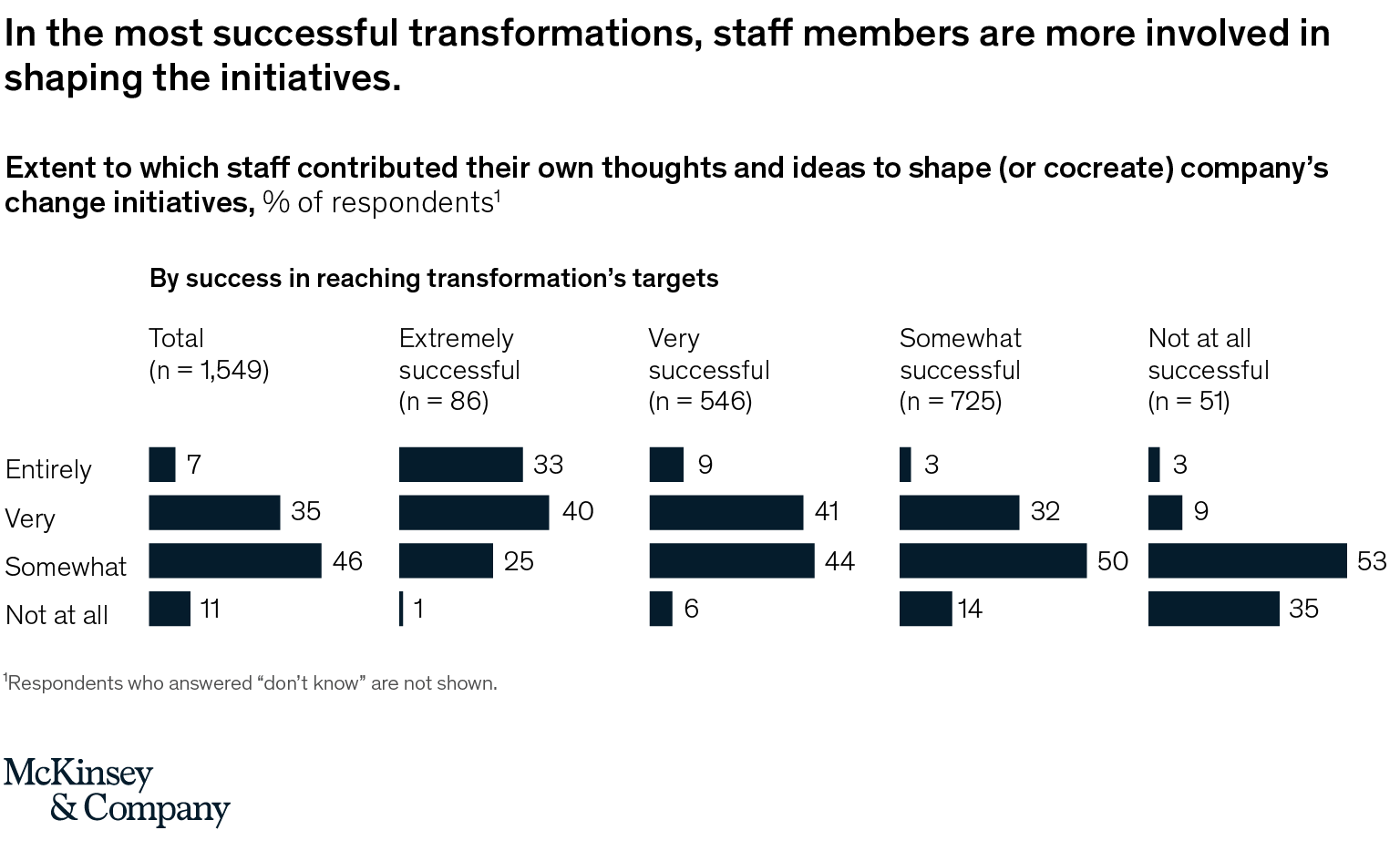After 15 years of original McKinsey research on organizational transformations,1 the results from our latest McKinsey Global Survey confirm an enduring truth: the more transformation actions a company takes, the greater its chances for success.2 Yet success remains the exception, not the rule. While we’ve known for years that a comprehensive approach to organizational transformation is more conducive to lasting change, the average success rate has remained persistently low. Less than one-third of respondents—all of whom had been part of a transformation in the past five years—say their companies’ transformations have been successful at both improving organizational performance and sustaining those improvements over time.
But even companies with successful transformations don’t always capture the full financial benefits of these efforts. So we took a closer look at the different stages of a transformation’s life cycle to understand where value is lost and what companies can do to preserve it. According to our analysis, three core actions of a transformation are especially predictive of value capture—and the companies with successful transformations are more likely than the rest to pursue the specific tactics that support them.
The value at stake from transformations
The survey results confirm that there are no shortcuts to success. The main differentiator between success and failure was not whether an organization followed a specific subset of actions but rather how many actions it took throughout an organizational transformation’s life cycle (Exhibit 1).3

At the same time, the results suggest that even successful organizational transformations deliver less than their full potential. Respondents reporting success estimate that, on average, their organizations have realized only 67 percent of the maximum financial benefits that their transformations could have achieved. By contrast, respondents at all other companies say they captured an average of only 37 percent of the potential benefit. Similarly, there’s room for many companies to improve their timing; even the companies with successful transformations could have benefited from speeding things up (for more on the transformation’s timeline, see sidebar “Accelerate the timeline for capturing value”).
What’s more, while much of a transformation’s value loss (55 percent) occurs during and after implementation, a sizeable portion happens as early as day one (Exhibit 2). On average, respondents say that nearly one-quarter of value loss occurs during the target-setting phase, suggesting that the full potential might be compromised before companies’ transformations even get started.

Yet even after the implementation phase, a company’s hard work is not done. According to respondents, 20 percent of value loss occurs after implementation, once the initiatives have been fully executed. To mitigate this loss, the results suggest that embedding transformation disciplines into business-as-usual structures, processes, and systems can help—and that this is a more common practice among successful transformations. In particular, companies that have undergone successful transformations are more likely than others to have made substantial changes to their annual business-planning processes and review cycles, from executive-level weekly briefings and monthly or quarterly reviews to individual performance dialogues (Exhibit 3).

Three positive indicators of value capture
While no single action or group of actions defines transformation success, our analysis shows that three actions are positive indicators for transformations capturing the most value, and they should be prioritized from the start:
Completing a comprehensive, fact-based assessment of the business to identify opportunities for improvement. The more thoroughly that an organization uses facts to assess the maximum financial benefit it can achieve from a transformation in the first place, the more confidence leaders will have in setting and pursuing ambitious yet realistic targets that reflect the transformation’s full potential.
Setting an overall financial target for the transformation is one of the most important steps to take, as it sets the tone for the whole program and what’s possible; if companies set high expectations, people tend to meet them. In an in-depth review of 15 transformations, we found that companies on average deliver 2.7 times more value than their senior executives thought possible when the transformations got under way. Other McKinsey research shows the power of high expectations: companies that set transformation targets at 75 percent or higher of their trailing earnings are more likely to earn outsize total shareholder returns (TSR).
Adapting goals for employees at all levels. It’s not enough to set effective and ambitious aspirations for the transformation. People need to understand what these goals mean for their day-to-day jobs and what they will be expected to do differently; if they don’t know how they connect to the transformation, their behaviors and how work gets done won’t change. But the survey results suggest a possible perception gap: senior leaders are nearly 20 percent more likely than people in other roles to believe that their transformation’s goals have been adapted for relevant employees across the organization.
Making an organizational transformation’s goals tangible for all employees takes more than just one-way communication. We see from the survey that the most successful organizations are more likely to involve employees and engage them in face-to-face communication: specifically, using line-manager briefings (cited by 65 percent of respondents whose transformations were successful), leadership town halls, and a cascade of information throughout the business (for more on employee communication and engagement, see sidebar “The power of influencers”) (Exhibit 4).

Allocating high performers to the highest-value initiatives. According to our survey, the organizational transformations that come close to realizing their full financial benefit are more likely than others to match their best talent to their most important initiatives. This further emphasizes the importance of linking business and talent priorities by having a clear view of where value is generated in the company, and who in the organization has the experience and skills to deliver that value.
Other McKinsey research shows that the burden placed on these high performers can be too high. Rather than overloading high performers with too many initiatives, companies should keep these individuals focused on the biggest, and often highest-profile, initiatives that make up 5 percent or more of the total value (which, on average for successful transformations, comprise only 5 percent of the total portfolio of initiatives). For smaller initiatives, it’s best to involve a wider coalition of managers and employees, which builds broader buy-in and reduces the potential for delayed value capture.
Our survey results indicate that companies’ transformation efforts remain stuck. The 30 percent success rate hasn’t budged after many years of research, and we now know that even successful transformations still leave value on the table. In a period of such prolonged and dramatic change in business, the economy, and the world at large, the newest results suggest that it’s time for companies to treat transformations as more than just a side project or discrete event and use them as opportunities to fundamentally change how their business runs. When a company frees up its bandwidth from other initiatives and focuses its resources and energy solely on a transformation, then it’s possible to take the truly holistic approach that success requires.
Download “Losing from day one: Why even successful transformations fall short” (PDF–428KB).
About the author(s)
The survey content and analysis were developed by Michael Bucy, a senior partner in McKinsey’s Charlotte office; Bill Schaninger, a senior partner in the Philadelphia office; Kate VanAkin, a senior expert in the London office; and Brooke Weddle, a partner in the Washington, DC, office.
The authors wish to thank Anne Blackman, Kevin Blasko, Jacquie Hudson, Randy Lim, Lauren Patrick, and Amanda Sims for their contributions to this work.
This update was edited by Daniella Seiler, a senior editor in the New York office.

McKinsey’s original survey research
The people power of transformations
A new survey suggests that for their transformations to succeed, organizations need employee buy-in at all levels, consistent communication, and better people strategies.
Organizational transformations are hard work, and according to the latest McKinsey Global Survey on the topic4, companies are no more successful at overhauling their performance and organizational health than they were ten years ago5. A particular blind spot seems to be the failure to involve frontline employees and their managers in the effort.
Transformations have their truisms. Successful ones, for example, require visibly engaged C-suite leaders who communicate clearly about the changes at hand. A vast majority of all respondents report these characteristics at their companies, whether or not their transformations have worked. But the results suggest that while C-level support is necessary, it is not by itself sufficient. A transformation’s success also requires that people across the organization have a specific role to play and that everyone knows how to carry out his or her part.
Our survey asked about seven specific roles and the actions that employees in these roles take during a transformation.6 For each one, and most notably for roles at lower levels of the organization, respondents at companies with the most successful transformations report overall greater degrees of involvement. Respondents at these companies also are likelier to report other practices that set their transformations apart: consistent communication around the changes being made, especially to those on the front line; clear definitions of roles and responsibilities; and a strategic approach to talent management. In contrast, responses suggest that without employees at all levels having a stake in the outcome, the transformation might well be doomed. Among respondents whose companies’ transformations failed to engage line managers and frontline employees, only 3 percent report success, compared with success rates of 26 and 28 percent, respectively, when each of these groups is engaged.
Would you like to learn more about our People & Organizational Performance Practice?
Look beyond the C-suite
Among respondents, there is clear consensus that company leaders are deeply involved in and committed to transformational change (Exhibit 1). Even on the front line, 84 percent of respondents say their CEOs are very or somewhat engaged. So do a majority of respondents at companies where the transformation failed,7 suggesting that CEO buy-in is a critical and therefore expected part of a transformation. Indeed, when asked which role has had the greatest impact on transformation results, respondents across the organization cite CEOs most often.

What really sets the more successful transformations apart, according to the results, is the involvement of frontline employees and their managers. Many companies seem to miss this: respondents rate these groups (along with their human-resources leaders) as the least engaged in transformations. At successful companies, though, respondents are much likelier to report visibly engaged frontline employees: 73 percent do, compared with 46 percent of all other respondents (Exhibit 2).

Not surprisingly, involving the front line is even more challenging at larger companies, where the rate of transformation success is also lower.8 Just 45 percent of respondents at larger firms, compared with 58 percent at smaller firms, say frontline employees are visibly engaged in transformations. The same is true of line managers: respondents at bigger companies are less likely than their smaller-company peers to say their line managers—who oversee frontline work and whose activities are directly affected by transformation initiatives—are engaged in the effort.
It’s not surprising, then, that these groups are the least likely to view their companies’ transformations as successful (Exhibit 3). Yet their involvement and perspective could not be more critical: among transformations that fail to engage either line managers or frontline employees, only 3 percent of respondents report success.

The difference that good communication makes
While frontline engagement is so important to a transformation’s outcome, few respondents report that their organizations built broad ownership of the change effort. Only 39 percent of all respondents—and 11 percent at companies with failed transformations—say so. One way to build ownership is with effective communication, which emerged in earlier work as a key factor of transformation success. In our previous survey, the largest share of respondents said that if their organizations pursued a transformation again, they would spend more time communicating a change story about the effort.9
This year’s responses suggest that communication remains top of mind for respondents at all levels. When asked how their companies are engaging frontline employees, respondents most often identify techniques that involve communication—for example, communicating about the need for the transformation and the transformation’s objectives. When asked which factors have been most effective, they also select communication-related actions often. But frontline employees sometimes differ from other respondents about which actions have actually worked (Exhibit 4). Just 16 percent of all respondents say regular access to information on the effort’s progress is an effective way to engage the front line. But nearly twice the share of frontline respondents say the same.

Still, the most successful companies are much better than others at creating clear lines of communication (Exhibit 5). Two-thirds of respondents at these organizations say they provide regular access to information on the transformation’s progress, compared with about half of all respondents and 28 percent of those with failed transformations. Respondents at successful companies are also likelier than others to report that CEOs and senior leaders are visibly engaged and committed to the transformation.

The people—and people strategies—that make transformations work
Transformation success isn’t contingent upon the front line alone, of course. The results suggest that when everyone in the organization plays their own unique roles, the odds of success are much greater (see sidebar, “A transformation’s critical roles”). But what does the right role look like? According to respondents, company leaders contribute most to a transformation when they articulate a vision and communicate actively. A transformation is 5.8 times more likely to be successful at organizations where CEOs communicate a compelling, high-level change story, and 6.3 times likelier when senior leaders share aligned messages about the change effort with the rest of the organization (Exhibit 6). The leaders of program-management offices have the greatest impact on success when they identify barriers to change and circulate knowledge, while the leaders of transformation initiatives are likeliest to make a difference when they take full ownership of their individual initiatives. And for line leaders, it’s most important that they make the transformation tangible and digestible for their employees.

With respect to human-resources leaders, respondents report that their role is relatively small. Only 56 percent of respondents say this group was visibly engaged, compared with 85 percent who say so of other senior leaders. When HR leaders are involved, the odds for success are greatest when they communicate the connection between human-resources objectives and the transformation’s—though their actions are perceived to have less of a bearing on success than the actions of other roles.
Change agents, in contrast, appear to have a notable impact on success. Less than half of respondents say their organizations select these employees, who dedicate a significant part of their time to work as facilitators or agents of the transformation. But those who do report overall success more often than other respondents—and are twice as likely to report success at transforming their organizational cultures. Change agents have the greatest impact on success when they model new mind-sets and behaviors for others (including the front line) to follow and when they support employees to develop the capabilities and mind-set changes they need to succeed in the new environment.

Transformation with a capital T
In addition to defining specific roles—and identifying how employees can contribute most to a transformation—companies also need to move people around and even out of the organization, though in moderation. Just one-quarter of respondents strongly agree that their senior leaders replace people on their teams who aren’t personally committed to the changes being made. But when they do, the organization’s transformation is much likelier to succeed. In organizations where senior leaders replace uncommitted people, 29 percent of transformations succeed, compared with 6 percent where leaders keep those people in place. Compared with transformations that fail to improve performance or culture, these successful transformations are also likelier to bring in new talent and move people internally, rather than moving them out (Exhibit 7).

Looking ahead
In response to some of the challenges that the survey results revealed, here are a few steps that companies can take to support the success of their transformations:
- Show—don’t tell—progress to the front line. When large companies embark on a transformation, there is a risk that frontline employees will see only the individual pain and not the aggregate gain. Communicating clearly and creatively in a way that stimulates dialogue around the transformation’s ambition and progress further increases the chances of success. Techniques such as regular surveys taking the organization’s cultural pulse, and progress parties celebrating a transformation’s milestones, can help create a foundation for real dialogue between senior leaders and the front line on the transformation and the potential changes to be made.
- Involve HR as a strategic partner. Transformations have a significant impact on employees and therefore require active involvement from human resources. Yet respondents tend to perceive their HR leaders as less critical than other senior roles to the transformation’s outcome. For this view to change, the HR leader must set up his or her function to position itself strategically at the center of the transformation, rather than playing a transactional role. This will allow HR to make full use of its expertise and contribute to the transformation in important ways, such as moving people around the organization—in moderation. One way for HR to add value in a transformation is by taking a clean-sheet approach to the organization’s new, posttransformation design, then using strategic workforce-planning tactics (such as recruitment, talent development, and dismissal) to achieve that vision.
- Engage employees through new channels. The survey results suggest that reaching the front line is a greater-than-average challenge at larger companies. But companies of all sizes can benefit from creative, more digital approaches to engaging employees in a transformation. The use of social media, change-management apps or games, and live-feedback tools should support and complement the movement of information from the top to the rest of the organization, rather than replace traditional methods. Such approaches can do so by making communication more tailored and personal to individual employees (for example, sending personalized push notifications if a milestone has been reached) and by providing more regular updates on the state of the transformation. Employees can also use these tools to explore and engage with the changes being made, on their own terms and with the ability to provide feedback. More advanced communication tools will be especially helpful in large companies that struggle to engage the front line and in companies with many different sites or locations.
Download “The people power of transformations” (PDF–2.6MB).
About the author(s)
The contributors to the development and analysis of this survey include Dana Maor, a senior partner in McKinsey’s Tel Aviv office; Angelika Reich, a partner in the Zurich office; and Lara Yocarini, an associate partner in the Paris office.
They wish to thank Claire Barnett, Surbhi Sikka, and Lukas Wallrich for their contributions to this work.
This update was edited by Daniella Seiler, a senior editor in the New York office.
How to beat the transformation odds
Transformational change is still hard, according to a new survey. But a focus on communicating, leading by example, engaging employees, and continuously improving can triple the odds of success.
After years of McKinsey research on organizational transformations,10 the results from our latest McKinsey Global Survey on the topic confirm a long-standing trend: few executives say their companies’ transformations succeed.11 Today, just 26 percent of respondents say the transformations they’re most familiar with have been very or completely successful at both improving performance and equipping the organization to sustain improvements over time. In our 2012 survey, 20 percent of executives said the same.12
But some companies have beaten the odds. We asked respondents whether their organizations follow 24 specific actions that support five stages of a transformation.13 At organizations that took a rigorous, action-oriented approach and completed their transformations (that is, all of their initiatives have been fully implemented), executives report a 79 percent success rate—three times the average for all transformations. According to the results, no single action explains the difference; in fact, the more actions an organization takes, the more likely its transformation is to succeed. Still, the results suggest that some transformation practices correlate much more closely than others with success. These practices include communicating effectively, leading actively, empowering employees, and creating an environment of continuous improvement so organizations can keep their performance from stagnating (or even regressing) once a transformation’s goals are met14. By implementing continuous-improvement activities that enable the organization to look regularly for new and better ways to work, respondents’ organizations double their chance of successfully sustaining improvements after the transformation.
The power of action—and communication
To test which transformation practices correlate most with success, we asked executives about 24 specific actions that support a transformation’s five stages (see sidebar, “The 24 actions of transformation”). Indeed, the results indicate that when organizations follow a rigorous approach and pursue all of these actions during a transformation, the overall success rate more than doubles from the average (26 percent), to 58 percent (Exhibit 1). Among only completed transformations, respondents report a success rate of 79 percent—about triple the average success rate for all transformations.

While the results show that success links closely to a greater overall number of actions, they also indicate that not all 24 actions are created equal. Communication, specifically, contributes the most to a transformation’s success (Exhibit 2). At companies where senior managers communicate openly and across the organization about the transformation’s progress, respondents are 8.0 times as likely to report a successful transformation as those who say this communication doesn’t happen. Good communication has an even greater effect at enterprise-wide transformations, where company-wide change efforts are 12.4 times more likely to be successful when senior managers communicate continually.

It also helps when leaders develop a clear change story that they share across the organization. This type of communication is not common practice, though. When asked what they would do differently if the transformation happened again, nearly half of respondents (and the largest share) wish their organizations had spent more time communicating a change story.
Lead, don’t manage
According to respondents, leadership matters as much during a transformation as it does in the company’s day-to-day work. It can’t be delegated to a project-management office or central team—the presence (or not) of which has no clear bearing on a transformation’s success—while executives carry on with business as usual. Indeed, when senior leaders role model the behavior changes they’re asking employees to make (by spending time on the factory floor or in the call center, where work is done), transformations are 5.3 times more likely to be successful (Exhibit 3). Success is twice as likely when senior leaders and the leaders of initiatives spend more than half of their time on the transformation. In practice, though, only 43 percent of these leaders say they invested that much working time in the transformation’s initiatives.

But even if they’re involved, senior leaders face some potential pitfalls. First is the perception gap between them and everyone else in the organization (Exhibit 4). Eighty-six percent of leaders say they role modeled the desired behavior changes when transformation initiatives were being implemented, yet only half of all employees who were part of the transformation (but didn’t play an active role) say the same. Overall, senior leaders are also 2.5 times as likely as other employees to rate their companies’ transformations a success.

A second pitfall, in addition to outsize optimism, is overplanning. Few initiative leaders—only 22 percent—say they would spend more time planning the transformation if they could do it over again. Instead, these respondents most often say they would spend more time communicating a change story (49 percent) and aligning their top team (47 percent).
Choose the right people and empower them
An involved team of senior leaders is only half the battle. Executives report that for transformations to truly succeed, companies must think about the role that employees play as well as their people needs across the organization. If the transformation happened again, the largest share of executives say they would move faster to keep people resistant to changes out of leadership or influencer roles.15
According to respondents, it’s important to define clear roles so employees at all levels are prepared to meet the post-transformation goals—a factor that makes companies 3.8 times more likely to succeed (Exhibit 5). Also key to an effective people strategy is allocating enough employees and the right ones—that is, the high performers and active supporters—to work on the transformation. One effective way to hold these people accountable, according to the results, is using transformation-related metrics. Executives who say their initiatives’ leaders were held accountable for their transformation work in annual evaluations are 3.9 times more likely than others to report a successful transformation.

Prepare for continuous improvement
Once initiatives are fully implemented, the change effort does not end; almost 40 percent of respondents say they wish they had spent more time thinking about how their organizations would continue to improve. Several specific practices that help companies connect strategy to daily work, deliver value more efficiently to customers, enable people to contribute to their best ability, and discover new ways of working all link to an organization’s long-term health—and can keep companies from backsliding on performance gains and support continuous improvements after transformation.
For example, in organizations where people understand how their individual work supports the company’s broader vision, executives are 5.5 times likelier than others to say the transformation has been successful (Exhibit 6). To achieve long-term success, that link must also be reinforced with a company-wide commitment to identifying opportunities for improvement—a practice that more than quadruples the likelihood of success. Likewise, executives report a much higher rate of success when their companies have a systematic process for developing people’s capabilities and for identifying, sharing, and improving upon best practices.

Of the eight continuous-improvement actions we asked about, one was an outlier: only one-third of executives say teams of employees begin their days discussing the previous day’s results and the current day’s work, compared with strong majorities of executives who agree that their organizations take each of the other actions. But respondents whose organizations had implemented daily discussions were twice as likely as others to report success.
Looking ahead
Focus on people, not the project. Transformations are about the people in the organization as much as they’re about the initiatives. The long-term sustainability of a transformation requires companies to engage enthusiastic high-potential employees, equip them with skills, and hold them accountable for—as well as celebrate—their contributions to the effort. Companies should, in our experience, take the same steps toward developing people throughout the organization. To build broad ownership, leaders should encourage all employees to experiment with new ideas: starting small, taking risks, and adapting quickly in their work. Doing so can create far-reaching and positive support for change, which is essential to a transformation’s success.
Communicate continually. When embarking on a transformation, executives should not underestimate the power of communication and role modeling. The results suggest that continually telling an engaging, tailored story about the changes that are under way—and being transparent about the transformation’s implications—has substantially more impact on an effort’s outcome than more programmatic elements, such as performance management or capability building. But the communication doesn’t end once the change story has been told. Leaders must continually highlight progress and success to make sure the transformation is top of mind across the organization—and to reduce the gap between what employees believe is happening and what they see.
Take more action. Transformation is hard work, and the changes made during the transformation process must be sustained for the organization to keep improving. There is no silver bullet—and while some factors have more impact than others on a transformation’s outcome, the real magic happens when these actions are pursued together. Overall, the survey indicates that the more actions an organization took to support each of the five stages of transformation, the more successful it was at improving performance and sustaining long-term health.
Download “How to beat the transformation odds” (PDF–1.6 KB).
About the author(s)
The contributors to the development and analysis of this survey include David Jacquemont, a principal in McKinsey’s Paris office; Dana Maor, a principal in the Tel Aviv office; and Angelika Reich, an associate principal in the Zurich office.
They would like to acknowledge Erin Ghelber, Christian Johnson, and Kate VanAkin for their contributions to this work.
This update was edited by Daniella Seiler, a senior editor in the New York office.
What successful transformations share
When organizational transformations succeed, managers typically pay attention to “people issues,” especially fostering collaboration among leaders and employees and building capabilities.
Over years of research and client work, we’ve identified a few tactics that help drive successful transformational change—any large-scale change, such as going from good to great performance, cutting costs, or turning around a crisis. These tactics include setting clear, aspirational targets; creating a clear structure; maintaining energy and involvement throughout the organization; and exercising strong leadership.16 In this latest survey of executives from around the world,17 we’ve dug into just how companies apply some of these tactics. We found that a few approaches in each area are most tightly correlated with successful transformations of both short-term performance and long-term corporate effectiveness, or “health.” In addition, the approaches most used by successful companies tend to complement and reinforce one another.
The survey asked executives about types of transformations (what types their companies had undertaken and why), goals for the transformation (what the goals were, how they were defined, and how successfully they were met), and implementation (how companies structured and carried out the transformation).
By looking at the approaches used by companies that executives describe as most successful in transforming themselves, we found evidence suggesting the importance of engaging employees collaboratively throughout the company and throughout the transformation journey. Another major theme was the importance of building capabilities—particularly leadership capabilities—to maintain long-term organizational health. In addition, a focus on strengths and achievements, not just problems, throughout the entire transformation process is strongly tied to success.
Building a clear structure collaboratively
This survey reconfirms the importance of some basic best practices to successful transformations. Strong majorities of extremely successful companies define the targets, role, and structure of the transformation clearly, respondents say.
Furthermore, this survey allows us to identify some approaches for creating a change plan that are closely tied to success: assessing a company’s present situation rigorously, identifying the current state of corporate capabilities as well as problems, and explicitly identifying the underlying mind-sets that must change for the transformation to succeed (Exhibit 1). In addition, nearly three-quarters of companies that were extremely successful in meeting their transformational goals broke down the process of the transformation into specific, clearly defined initiatives. Other structural approaches, such as a robust risk-management process or a project-management office, are less often correlated with successful transformations.

Notably, employee engagement as early as the planning process emerges as a key success factor. Indeed, in successful transformations, executives say that identifying underlying mind-sets that would need to change was the approach used most often. Moreover, three-quarters of the respondents whose companies broke down their change process into clearly defined smaller initiatives and whose transformations were “extremely successful” say that staff members were entirely or very able to participate in shaping those change initiatives (Exhibit 2). Collaboration and cocreation also are important: nearly a quarter of the extremely successful transformations were planned by groups of 50 or more, compared with just 6 percent of unsuccessful transformations.18

Engaging employees
Strong leadership and maintaining energy for change among employees are two principles of success that reinforce each other when executed well. For example, when leaders ensure that frontline staff members feel a sense of ownership, the results show a 70 percent success rate for transformations. When frontline employees take the initiative to drive change, transformations have a 71 percent success rate. When both principles are used, the success rate rises to 79 percent.
Among all of the structural and executional approaches to change we asked about, five of the eight used in strong majorities of successful transformations relate to ensuring that employees are engaged, often by leadership initiatives (Exhibit 3). Furthermore, among the respondents whose companies used small-scale initiatives to roll out their change programs, 60 percent of the extremely successful ones focused some initiatives entirely or mostly on changing mind-sets, compared with only 12 percent of the unsuccessful transformations.
Keys to success

Leadership and capabilities
Eighty-three percent of all respondents say their companies’ transformations focused wholly or in part on changing the organizations’ long-term health by building capabilities, changing mind-sets or culture, or developing a capacity for continuous improvement. Transforming leadership capacity seems to be particularly significant in transformations that succeeded in improving long-term health: 63 percent of executives who say their companies’ transformations had a significant impact on leadership capacity indicate that the transformation improved both short-term performance and long-term health. By contrast, a third of those who say their companies’ transformations had no significant effect on leadership capacity nonetheless succeeded in transforming short-term performance—a rate of success almost as high as the rate for any transformation.
Further, 69 percent of respondents who have an opinion say their companies’ transformations led to a greater capacity for continuous improvement.19 One of the two main reasons, chosen by 61 percent, is that staff gained new skills through the transformation. The other reason, chosen by an equal share, is that the companies’ cultures became more supportive of innovation and improvement.
Accentuate the positive
We found in earlier work that when communications about an organization’s transformation celebrate success as well as discuss reasons for change, the organization tends to be more successful in driving the transformation than when communications focus solely on reasons for change. In this survey, we’ve found that focusing on the positives early in the process—during the assessment of a company’s current position—also correlates strongly with success (Exhibit 4).
Assessing strengths, opportunities, and problems

Looking ahead
- Companies that undertake transformational change have to succeed at the basics, such as creating clear, stretching targets and defining a clear structure. In addition, this survey suggests that the more companies also focus on their employees’ mind-sets and behavior, the more successful they will be.
- It can be hard to find time to pay attention to mind-sets and behavior, given all the other work of a transformation. Companies that focus on the few approaches this survey shows to be frequently tied to success can use their limited resources wisely.
- Given the importance of collaboration across the whole organization, leaders at companies starting a transformation should put a priority on finding efficient and scalable ways to engage employees.
Download “What successful transformations share” (PDF–472 KB).
About the author(s)
Contributors to the development and analysis of this survey include Scott Keller, a principal in McKinsey’s Chicago office; Mary Meaney, a principal in the London office; and Caroline Pung, a consultant in that office.
They would also like to acknowledge the contributions of Caroline Limet.




